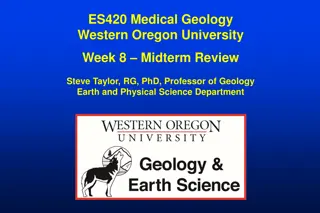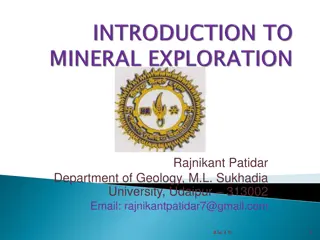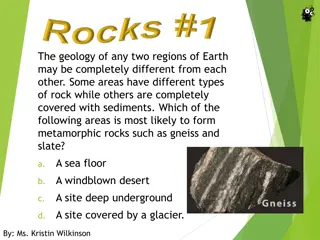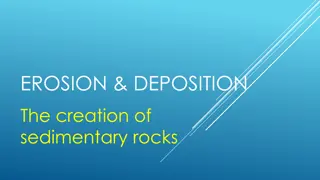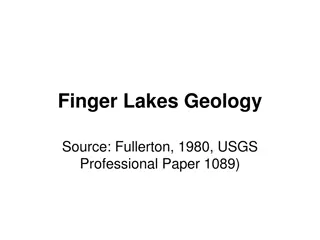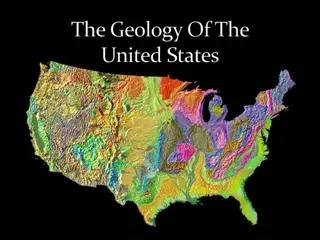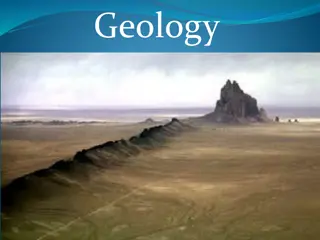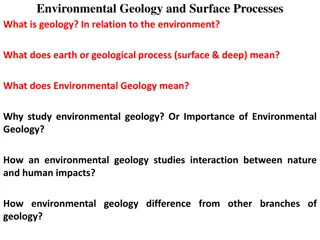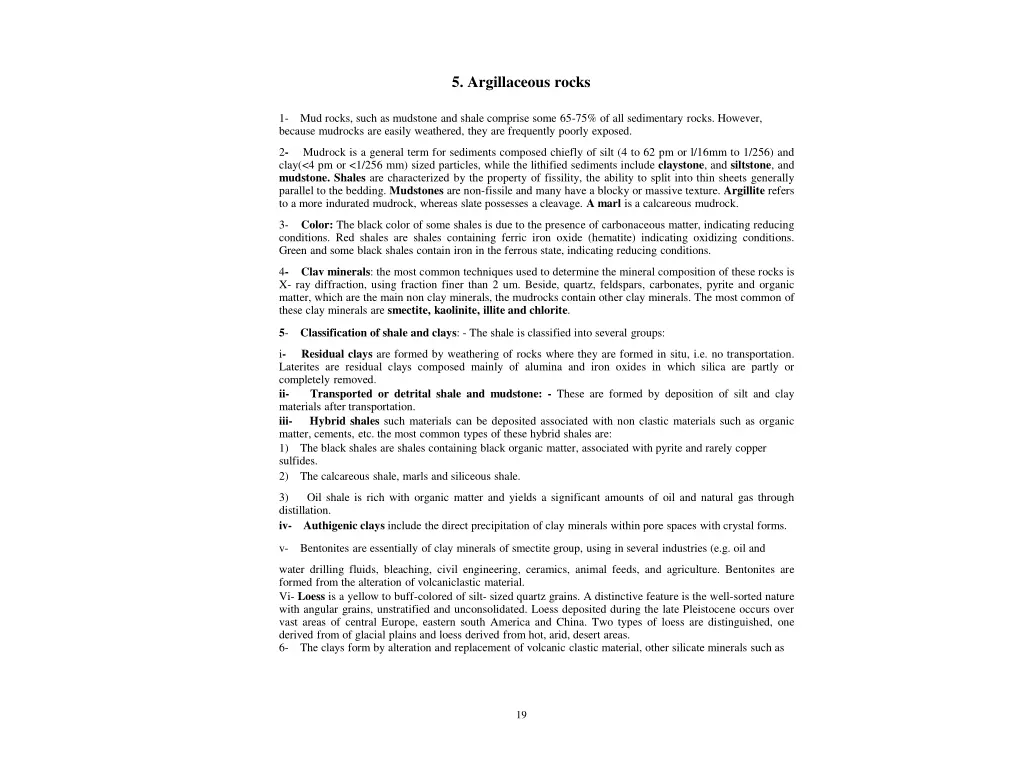
Understanding Argillaceous Rocks: Composition, Formation, and Classification
Argillaceous rocks, such as mudstone and shale, are prevalent in sedimentary rocks, comprising 65-75%. Learn about their composition, color variations, classification, and diagenesis processes affecting mudrocks and clay minerals.
Download Presentation

Please find below an Image/Link to download the presentation.
The content on the website is provided AS IS for your information and personal use only. It may not be sold, licensed, or shared on other websites without obtaining consent from the author. If you encounter any issues during the download, it is possible that the publisher has removed the file from their server.
You are allowed to download the files provided on this website for personal or commercial use, subject to the condition that they are used lawfully. All files are the property of their respective owners.
The content on the website is provided AS IS for your information and personal use only. It may not be sold, licensed, or shared on other websites without obtaining consent from the author.
E N D
Presentation Transcript
5. Argillaceous rocks 1- Mud rocks, such as mudstone and shale comprise some 65-75% of all sedimentary rocks. However, because mudrocks are easily weathered, they are frequently poorly exposed. 2- Mudrock is a general term for sediments composed chiefly of silt (4 to 62 pm or l/16mm to 1/256) and clay(<4 pm or <1/256 mm) sized particles, while the lithified sediments include claystone, and siltstone, and mudstone. Shales are characterized by the property of fissility, the ability to split into thin sheets generally parallel to the bedding. Mudstones are non-fissile and many have a blocky or massive texture. Argillite refers to a more indurated mudrock, whereas slate possesses a cleavage. A marl is a calcareous mudrock. 3- Color: The black color of some shales is due to the presence of carbonaceous matter, indicating reducing conditions. Red shales are shales containing ferric iron oxide (hematite) indicating oxidizing conditions. Green and some black shales contain iron in the ferrous state, indicating reducing conditions. 4- Clav minerals: the most common techniques used to determine the mineral composition of these rocks is X- ray diffraction, using fraction finer than 2 um. Beside, quartz, feldspars, carbonates, pyrite and organic matter, which are the main non clay minerals, the mudrocks contain other clay minerals. The most common of these clay minerals are smectite, kaolinite, illite and chlorite. 5- Classification of shale and clays: - The shale is classified into several groups: i- Residual clays are formed by weathering of rocks where they are formed in situ, i.e. no transportation. Laterites are residual clays composed mainly of alumina and iron oxides in which silica are partly or completely removed. ii- Transported or detrital shale and mudstone: - These are formed by deposition of silt and clay materials after transportation. iii- Hybrid shales such materials can be deposited associated with non clastic materials such as organic matter, cements, etc. the most common types of these hybrid shales are: 1) The black shales are shales containing black organic matter, associated with pyrite and rarely copper sulfides. 2) The calcareous shale, marls and siliceous shale. 3) Oil shale is rich with organic matter and yields a significant amounts of oil and natural gas through distillation. iv- Authigenic clays include the direct precipitation of clay minerals within pore spaces with crystal forms. v- Bentonites are essentially of clay minerals of smectite group, using in several industries (e.g. oil and water drilling fluids, bleaching, civil engineering, ceramics, animal feeds, and agriculture. Bentonites are formed from the alteration of volcaniclastic material. Vi- Loess is a yellow to buff-colored of silt- sized quartz grains. A distinctive feature is the well-sorted nature with angular grains, unstratified and unconsolidated. Loess deposited during the late Pleistocene occurs over vast areas of central Europe, eastern south America and China. Two types of loess are distinguished, one derived from of glacial plains and loess derived from hot, arid, desert areas. 6- The clays form by alteration and replacement of volcanic clastic material, other silicate minerals such as 19
feldspars and micas, through the normal sedimentary processes of erosion, transportation and deposition of fine-grained-material from suspension and/or formed through formed through in-situ weathering and soil formation upon pre-existing rocks and sediments. 7- Diagenesis of clay minerals and mudrocks i- The main physical post-depositional process affecting the mudrocks is compaction. Compaction in mudrocks expels water and reduces the thickness of the deposited sediment. ii- Further compaction through water loss requires temperatures approaching 100 C. Dehydration of clays then takes place, accompanied by some changes in the clay mineralogy. The main change is an alteration of smectite to illite via mixed-layer clays or smectite-illite. At slightly higher temperatures and greater depths, kaolinite is replaced by illite and chlorite. iii- With increasing degree of incipient metamorphism, there is an increase in the order or crystallinity of the illite lattice and changes in the chemical composition. illite is then replaced by sericite, a finely crystalline variety of muscovite and chorite. 8- Mudrocks and their depositional environments Mudrocks can be deposited in practically any environment although the major depositional sites are river floodplains and lakes, low-energy shoreline, lagoon, delta, outer-marine shelf and deep-ocean basin. Muds and mudrocks deposited in deeper water largely from suspension are termed hemipelagic. They are characterized by dominantly pelagic fauna, such as planktonic foraminifera, diatoms, radiolarians which have supplied much organic matter for petroleum generation as source rocks as in the Middle East oilfields. The mineralogy, boron contents, fossils, color are used in determined the depositional environments for siliciclastic rooks 20
1- Carbonate rocks are a class of sedimentary rocks composed of greater than 50 percent carbonate minerals. The two major types are limestone, which is composed of calcite or aragonite (different crystal forms of CaCO3) and dolostone, which is composed of the mineral dolomite (CaMg(CO3)2). Typically, carbonates form in warm, clear water free of clastic sediment. 2- Limestone is a sedimentary rock composed largely of the minerals calcite and aragonite, which are different crystal forms of calcium carbonate (CaCO3). Many limestones are composed from skeletal fragments of marine organisms such as coral or foraminifera. Some limestones are formed completely by the chemical precipitation of calcite or aragonite, i.e. travertine. Secondary calcite may be deposited by supersaturated meteoric waters (groundwater that precipitates the material in caves). This produces speleothems, such as stalagmites and stalactites. Another form is oolitic limestone. 3- Limestone makes up about 10% of the total volume of all sedimentary rocks. The solubility of limestone in water and weak acid solutions leads to karst landscapes, in which water erodes the limestone over thousands to millions of years, producing most cave system through limestone bedrock. 4- Mineralogy The carbonate grains of modern sediments are composed of aragonite, high-Mg calcite (>4% MgCo3) and low-Mg calcite(<4% MgCo3). Aragonite grains are very rarely preserved, where originally aragonitic fossils and ooids have been dissolved out producing moldic porosity, while metastable high-Mg calcite converts into low-Mg calcite. 5- Uses: Limestone has several uses: as reservoir rock, a building material, as bricks, cement, construction of roads, as white pigment. toothpaste or paints, and as a chemical feedstock. Limestone is very common in architecture, including the Great Pyramid and its associated complex in Giza, Egypt, are made of limestone. 6- Limestone components Three components make up the majority of limestones: Allochems (carbonate grains); orthochems mud/micrite (micro-crystalline calcite) and cement (usually calcite spar, also fibrous calcite) as well as detrital material (quartz and clay minerals). Limestone often contains varying amounts of clay, silt and sand carried in by rivers. A- Allochems: The principal carbonate grains are bioclasts (skeletal grains/fossils), ooids, peloids and intraclasts. i) Skeletal grains (bioclasts/fossils) are the dominant constituents of many Phanerozoic limestones. Most grains in limestone are skeletal fragments of marine organisms such as coral, mollusks (bivalves and gastropods), brachiopods, echinoderms (especially the crinoids), bryozoans, calcareous algae, stromatoporoids and foraminifera. These organisms secrete shells made of aragonite or calcite, and leave these shells behind after the organisms die. The types of skeletal grain present depend on environmental factors during sedimentation (e.g. water temperature, depth and salinity) as well as on the state of invertebrate evolution and diversity at the time. ii) Ooids are spherical to subspherical grains with internal structure, generally in the size range 0.2 to 0.5 mm, but reaching several millimetres in diameter. Structures larger than 2 mm are referred to as pisoids or pisolites. Ooids consist of concentric coatings around a nucleus, usually a carbonate particle or quartz grain. Most 21
modern marine ooids are composed of aragonite, but ancient ones were generally originally calcitic in midPalaeozoic and Jurassic-Cretaceous times and aragonitic (now calcite) at other times. Hg. 10 Modern ooids composed of aragonite from the Bahamas. Peloids have formed the nuclei. Plane polarized light 0-5 mm iii) Peloids are spherical, cylindrical or angular grains, composed of microcrystalline carbonate, but with no internal structure. The size of peloids may reach several mm formed by the algal micritization of skeletal fragments. Most peloids are of faecal origin and so can be referred to as pellets. Organisms such as gastropods and crustaceans produce pellets in vast quantities. Faecal pellets have a regular shape (<0.5mm in diameter) and they are rich in organic matter. They are most common in the sediments of protected environments such as lagoons and tidal flats. iv) Intraclasts are (geology) A fragment of limestone formed by erosion within a basin of deposition and redeposited there to form a new sediment.fragments of reworked carbonate sediment. Many are flakes up to several centimeters long, derived from desiccation of tidal-flat carbonate muds or penecontemporaneous erosion, especially by storms. The intraformational conglomerates formed in this way. Aggregates consist of several carbonate grains cemented together during sedimentation. B- Orthochems: i) Micrite is the matrix to many bioclastic limestone and the main constituent of fine-grained limestones. It consists of carbonate particles mostly less than 4 pm in diameter. Much modern carbonate mud, micrite is biogenic in origin, forming through the disintegration of carbonate skeletons such as calcareous algae. The origin of micrite in ancient limestones is obscure and it is often difficult to eliminate direct or indirect inorganic precipitation. ii) Sparite (sparry calcite, calcite spar) is clear, sometimes white and coarse, equant cement precipitated in the pore space between grains and in larger cavity structures. It is mostly a burial cement, although it can be a near-surface freshwater precipitate. The crystals may have unit or undulose extinction and they may be syntaxial with their substrate crystals (e.g. echinoid plates). iii) Fibrous calcite is cement, coating grains and fossils and lining cavities. This is generally of marine origin and is common in reef-rocks. The fibrous fringe is usually less than 200 um thick and consists of wedgeshaped crystals oriented normal to the substrate. To summarize, the main features of modern shallow-marine cements are the mineralogy: aragonite and high Mg calcite, and the fabrics: acicular, fibrous and bladed, or micritic. Meteoric cements are drusy sparites of low Mg calcite, associated with dissolution and replacement of aragonite skeletal grains. The mineralogical 22
and fabric differences between shallow-marine and meteoric cements are related to the Mg/Ca ratio (Folk, 1974). The high Mg/Ca ratio of seawater is thought to prevent the precipitation of low Mg calcite, but to allow the metastable forms aragonite and high Mg calcite to precipitate. The acicular and micritic habits of marine cements are also attributed to the effects of magnesium and possibly other ions, which poison crystal growth. Fresh waters have low Mg/Ca ratios and so permit precipitation of low Mg calcite, in the characteristic equant sparite habit HR. 11' The geometry of first generation cements: isopochous cement, indicative of precipitation in phreatic /ones where all pores arc filled with water (typical feature of low intertidal and suhtidal cements), and gravity (stalactitic) and meniscus cements, indicative of vadosc /one precipitation, as occurs in high intertidal, supralidal and shallow- subsurface continental situations. isopochous cement gravity (stalactitic) and meniscus cements 7- Classification of Limestone Three major classification schemes, size the Folk and the Dunham, are used for identifying limestone and carbonate rocks. A- Size of carbonate grains Table d.d Schemes for the classification of limestones: (A) on dominant grain- size; (B) on dominant constituent - prefixes can be combined if necessary, as in bio-oosparite t after R.L. Folk); am! fC) on dominant texture i after RJ. Dunham). A 2 mm 62 pm calciiudite I calcaremte I calcilutlte 23
Monocfy^talkoe synUnal orergroeh BdX-C synaxui overgro wth rorou* syntax) *! Overgrowth QM i . Wm m IV.'*'.. &*0*3 Figure * 12 Some importam types of sparry calcite cement fabrics in limestones. D * brachiopod. C crinoid. I intniclasL The change from btaded crystals to larger, granular crystals in the lower let! comer of the figure illustrates **dnisy' fabric. (After Folk. R. L., 19f 5, Some aspcc Ls of ir crystallization in ancient limestones, in Pray, L.C. and R. Murray (cds.). rktlomitiznton and Limestone Diagcnesiy. SEPM Special Publication 13, Fig. 6, p. 27, reprinted by permission of the Society Ibr Sedimentary Geology, Tulsa, OK.) B- Folk classification Robert L. Folk developed a classification system based on the detailed composition of grains and interstitial material in carbonate rocks. Based on composition, there are three main components: allochems (grains), matrix (mostly micrite), and cement (sparite). The Folk system uses two-part names; the first refers to the grains and the second is the root. Some limestones are formed in situ by the growth of carbonate skeletons as in reef limestones, or through trapping and binding of sediment by microbial mats (formerly algal mats) as in stromatolites and microbial laminites. Principal allochems in Limestone types cemented by spante with a rmcobc main* limestone iketetei grains {hanrUOn) biospante txomaente oo ds oospante oormerite peiotos poisperiie peirmcnte & ntreclasts ntrespente mtremiente Fig-13 Classification of limestones based on composition. After Folk (1962). bioMNte fenestrei limestone limestone formed in situ -dismicnte 24





